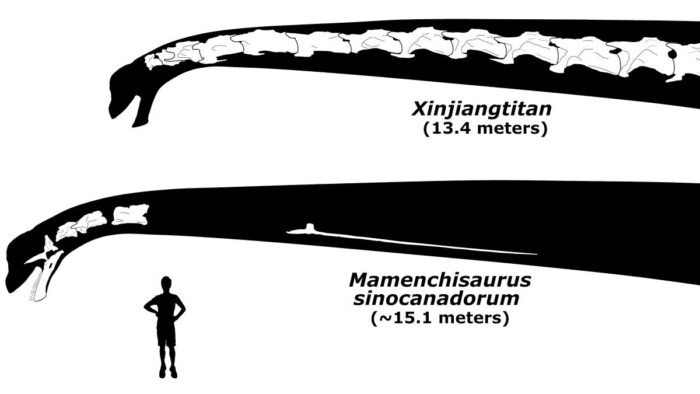Sauropods were a group of enormous dinosaurs that dominated the prehistoric landscape for hundreds of millions of years.
These herbivores are the largest land animals to have ever existed—four-legged beasts known for their remarkably long necks, which scientists believe were used to forage for plants to eat.
Nearly all sauropods would have dwarfed animals like elephants and giraffes. But among these beasts, there were giants, and then there were titans—sauropods who took the phrase 'long-necked' to seemingly impossible extremes.
And now, paleontologists have uncovered the longest neck of them all.
Meet Mamenchisaurus sinocanadorum, a mamenchisaurid (a sauropod family from what is now East Asia) whose life truly was a long story.
According to new research, this Jurassic herbivore had a neck that was 15.1 metres (49.5 feet) long, which is almost 2 m (6 feet) longer than the next longest sauropod neck (belonging to Xinjiangtitan shanshanesis). That's 3 m (10 feet) longer than a school bus. That's longer than eight giraffe necks.
Long neck, long time coming

Being able to compare the fossil of the M. sinocanadorum (below) to the more complete X. shanshanesis (top) was a huge breakthrough for researchers. (Andrew Moore)
Of course, if you are a little skeptical about this latest bit of dino news, that's fair. Like many fossils, paleontologists are working from a single site and from an incomplete fossil. A very incomplete fossil!
In this case, the scientists have a jawbone, some neck vertebrae (spinal column bones), and a few neck ribs that were found back in 1987! So, how do you confidently determine that this specimen is a sauropod, never mind the one with the longest neck ever known?
Welcome to paleontology, a science where making educated guesses is a huge part of the job.
Led by Andrew Moore of Stony Brook University in New York, these paleontologists compared the bones of M. sinocanadorum to those of other mamenchisaurids, like the X. shanshanesis we talked about earlier. We have an amazingly complete fossil of a X. shanshanesis neck, which was discovered in 2012. And that did two things.
It introduced us to that dinosaur for the first time. And, it gave researchers something to compare the M. sinocanadorum bones to.
Suddenly those bones from 1987 made a lot more sense!
The longest reach ever?
The new research from Moore not only helped to confirm M. sinocanadorum as a mamenchisaurid, it helped prove that this family was something exceptional.
"All sauropods had long necks," Moore told Live Science, "but mamenchisaurids were standouts, with some of the most extreme neck proportions of anything in the history of terrestrial life."
How did these animals manage to keep such enormous neck upright? A CT scan (like an X-ray) of the fossilized neck bones showed that they were actually around 77 percent air. Along with their long neck rib bones, this type of skeleton would've been both incredibly sturdy and surprisingly lightweight. (Though to be clear, altogether these beasts would've weighed more than 20 elephants!)
Will we ever find a more complete skeleton of this 162-million-year-old animal? Hopefully so. And if we do, it will be another fascinating piece of evidence that will bring the past world of these legendary giants into even clearer focus.
Talk about some huge news!
 An artist's rendering of the newly named sauropod, Mamenchisaurus sinocanadorum. ( Júlia d'Oliveira)
An artist's rendering of the newly named sauropod, Mamenchisaurus sinocanadorum. ( Júlia d'Oliveira)









😀
cool
😯